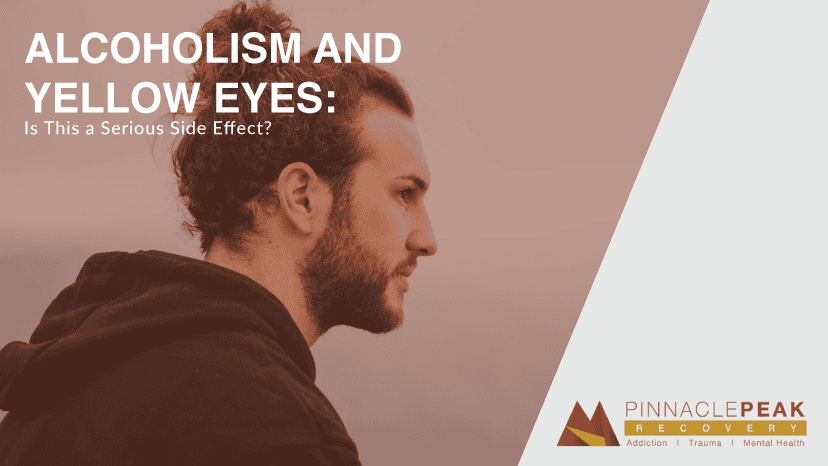You saw your dad drinking all the time growing up. There was never a moment when he didn’t have a beer or a mixed drink in his hand, and it didn’t matter what day of the week it was. Your mother would always try to shield you from his drunken outbursts, but you understood what was happening.
Despite always seeing him inebriated, you decided to start drinking in high school. It started as a few beers at parties on the weekends, but soon turned into every day after school. It was your way of bonding with your dad. Even though you never talked, you at least had that one thing in common. But lately, his health seems to be declining. He has gained so much weight over the years, and his bloodshot eyes now look like they’re yellow. Even his skin is turning a yellowish color. Is this from alcohol too?
In Arizona, 1,773 deaths from chronic liver disease/cirrhosis occurred in 2021. Pinnacle Peak Recovery has been working to educate the public on topics surrounding alcohol and substance use disorders. Our proven process for treatment has helped many find their success in recovery. Our blog serves as a free resource for parents and loved ones of those living with an alcohol use disorder. Today, we will be discussing alcoholism and yellow eyes, and what they mean for your loved one.
How Can Alcoholism Cause the Eyes to Turn Yellow?
Alcohol is processed in the liver. As the detoxification process takes place, a toxic chemical called acetaldehyde is produced. This is a known carcinogen and even though it is only in the body for a short time, the longer the person drinks, the more harm will occur. Conditions such as alcoholic hepatitis, cirrhosis, and liver disease can develop. A symptom of these conditions is yellowing of the skin and the whites of the eyes.
What Does It Mean?
When the eyes have turned yellow from excessive drinking, it is a sign that the liver is inflamed. Inflammation does not always signify a chronic condition, but it does indicate that the liver is not functioning to the best of its abilities. If not addressed, inflammation can lead to permanent damage and scar tissue. As scar tissue builds up, the liver will no longer be able to process and filter out toxins.
Think about a filter for a water pitcher. The filter will catch foreign metals and toxins and purify your drinking water. Over time, that filter will turn brown or grey, indicating it needs to be changed as it is too full to filter out toxins properly. The liver is essentially the same system, except there is no replacement. When scar tissue builds from constantly filtering alcohol toxins, that part of the liver will no longer be able to function. It will no longer filter alcohol or any toxins from the body.

Are Yellow Eyes Dangerous When They’re Caused by Too Much Alcohol?
Experiencing yellow eyes from drinking is a warning sign that the liver is in trouble. Yellowing of the eyes and skin is called jaundice and is a firm indicator to seek medical attention. Jaundice is caused by the liver being unable to get rid of bilirubin, a substance that is produced when old red blood cells break down. It is naturally yellow, and when the liver cannot process bilirubin, jaundice occurs. The only treatment for jaundice is to see a doctor. They will perform tests such as blood tests, CT and MRI scans, and a liver biopsy to see if there is damage to the liver and how severe it is.
Other Severe Symptoms Caused by Alcoholism
There are several severe symptoms that can be caused by alcoholism. Not only does alcohol affect the liver, it also affects the heart. Alcohol causes blood vessels to widen and constrict, making it difficult for the heart to regulate blood flow. This can lead to heart attacks, strokes, and cardiomyopathy. The heart muscle can become stretched, making it weaker and prone to failure.
The brain is also affected by alcohol dependence. Over time, damage can occur in the hippocampus region of the brain. This area controls memory and is responsible for recollection and storage. When the hippocampus is damaged, the brain has no way of storing new memories or recalling the past. Alcohol-related dementia can develop, and if drinking is not stopped, it can mimic Alzheimer’s disease.
As we discussed with jaundice, the liver is one of the main organs affected by alcoholism. When the body can not filter out toxins properly, other organs feel the effects. The kidneys, heart, lungs, and immune system are all compromised by liver complications. If the liver damage has progressed to the end stage, it cannot be reversed. There are stages of liver disease caused by alcohol: alcoholic hepatitis, fibrosis, and cirrhosis.
Alcoholic Hepatitis
Alcoholic hepatitis can happen to those who drink heavily for decades or even just a few years. It is the first stage of liver inflammation, and is commonly associated with yellowing eyes and skin. Other symptoms of alcoholic hepatitis include:
- Loss of appetite
- Unexplained weight loss
- Nausea or vomiting
- Fatigue
- Tenderness in the abdomen
- Low-grade fever
Those who are diagnosed with alcoholic hepatitis should stop drinking right away. The liver is capable of healing itself if drinking stops and the damage has not progressed too far.

Liver Disease and Cirrhosis
If drinking continues, liver damage can progress. Liver disease is a loose term used to describe any condition that affects the function of the liver. This can include alcoholic hepatitis, hepatitis A, B, or C, fibrosis, and cirrhosis. Cirrhosis is considered end-stage liver failure from alcohol use. There are two types of cirrhosis – compensated and decompensated. Compensated cirrhosis may go unnoticed for years, as there are still healthy liver cells keeping it functioning. Eventually, the healthy cells become overwhelmed and can no longer carry the weight of detoxifying the body. Symptoms of compensated cirrhosis include:
- Increased depression
- Fatigue
- Poor appetite
- Itching
- Yellowing eyes and skin
Decompensated cirrhosis is a complete failure of the liver. There may already be complications with other organs from toxicity buildup. At this point, regular visits with your care team will be necessary to provide medical interventions. A liver transplant may also be discussed if interventions are not working.
What Should I Do About Yellow Eyes From Drinking Alcohol?
If you are experiencing yellow eyes after drinking, it is time to see a doctor. Jaundice is rarely caused by conditions not involving the liver, however, it does occur. Pancreatic cancer and gallstones can cause jaundice. If you have been drinking heavily, chances are your yellow eyes are signaling a problem within the liver. No matter what, making an appointment with your doctor can give you peace of mind about what is going on with your body and causing yellowing eyes.
Are You Or A Loved One Experiencing Yellow Eyes From Alcohol Use?
Don't Wait For The Condition To Worsen. Call Us Today!
Seek Help for Alcoholism Today in Scottsdale, AZ
Whether you have been drinking for decades or only the last few years, experiencing yellow eyes is an indicator of an unhealthy relationship with alcohol. It may seem impossible to stop drinking, which is where treatment for alcoholism can make the difference. Finding a treatment center that understands your needs, focuses on your goals, and treats you like family can make all the difference in finding your success. Recovery is achievable for anyone, and taking the first step today is the only way to begin.
If you or someone you love is managing an alcohol use disorder while experiencing negative side effects like yellowing eyes, it’s time to seek help. Pinnacle Peak in Scottsdale, Arizona is ready to help you rediscover yourself and find solace without alcohol. Our team is dedicated to providing a comfortable and family-like atmosphere to ensure your healing is met with unwavering support. Call us today at 866-377-4761 to get started on your recovery journey.

